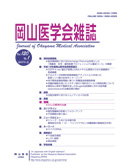

Journal of Okayama Medical Association
Published by Okayama Medical Association<Availability>
Full-text articles are available 3 years after publication.
Permalink : https://ousar.lib.okayama-u.ac.jp/40636
Immunohistochemical study of transthyretin in normal brain and brain tumors - Light and electron microscopic investigation with special reference to choroid plexus papilloma and ependymoma -
Kunishio, Katsuzo
Published Date
1990-06
Abstract
An immunohistochemical study of transthyretin (TTR), synthesized in the choroid plexus epithelia, was performed in normal brain tissue and 92 brain tumors. Glial fibrillary acidic protein (GFAP) and cytokeratin (CKER) were also examined in 11 choroid plexus papillomas (CPPs) and 19 ependymomas. A positive TTR reaction was observed diffusely in the majority of normal choroid plexus epithelia. All of the 11 cases of CPP were positive for TTR, but the other tissues and tumors (including ependymomas) were negative for TTR. GFAP -positive cells were occasionally found in five of the CPPs. The majority of the GFAP -positive cells were also positive for CKER, but not for TTR. There was an inverse relationship between the intensity of immunostaining for GFAP and for TTR in CPPs. Among the 19 cases of ependymomas, 16 were positive for GFAP, 3 for CKER, but none for TTR. TTR can be a very useful and diagnostic marker of CPP. A consective semithin-thin section microscopic method demonstrated abundant secretory granules and well-developed Golgi apparatus in TTR-positive cells. By immunoelectron microscopy using a pre-embedding method, a positive reaction for TTR was observed in the secretory granules. This result suggested that CPP cells as well as choroid plexus cells synthesize TTR de novo.
Keywords
transthyretin
choroid plexus papilloma
免疫組織化学
brain tumor
ISSN
0030-1558
NCID
AN00032489
